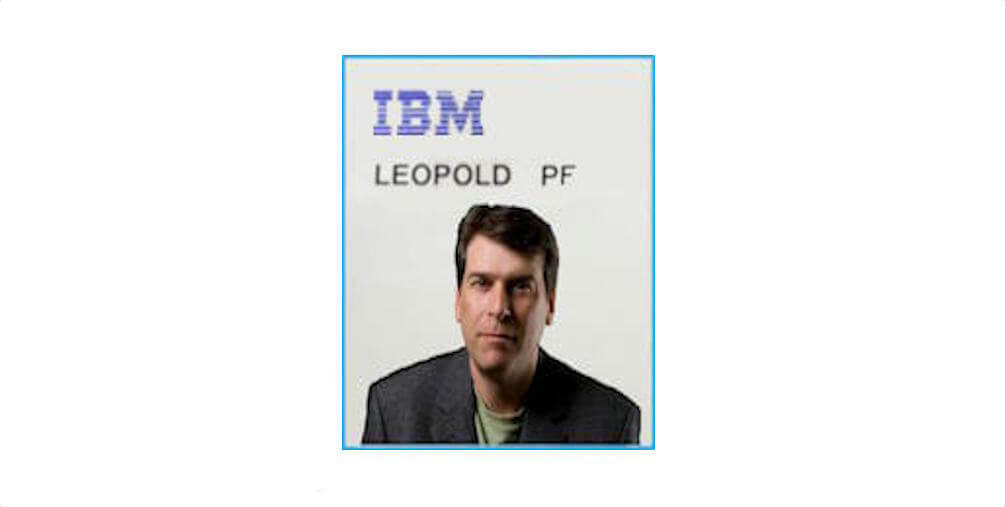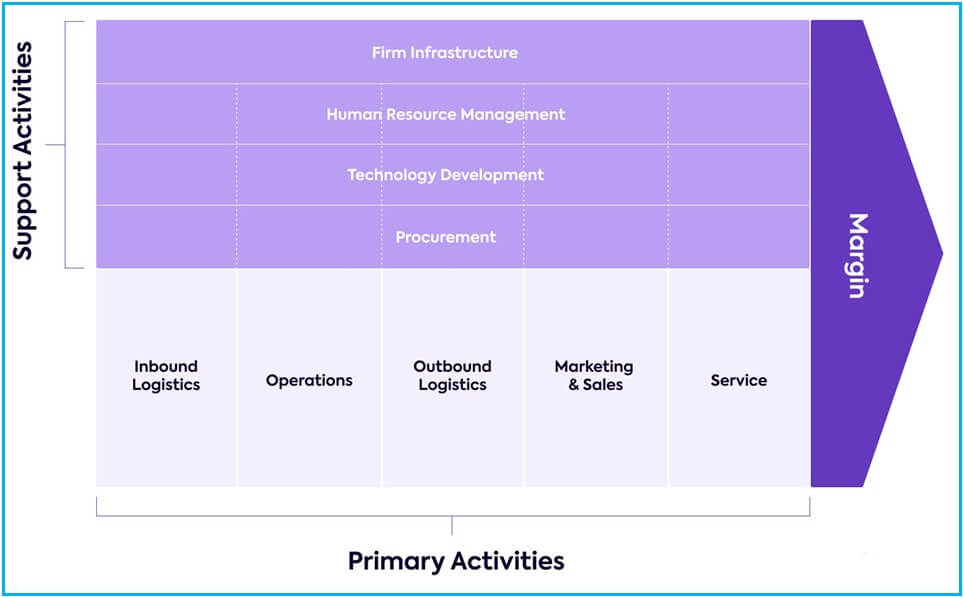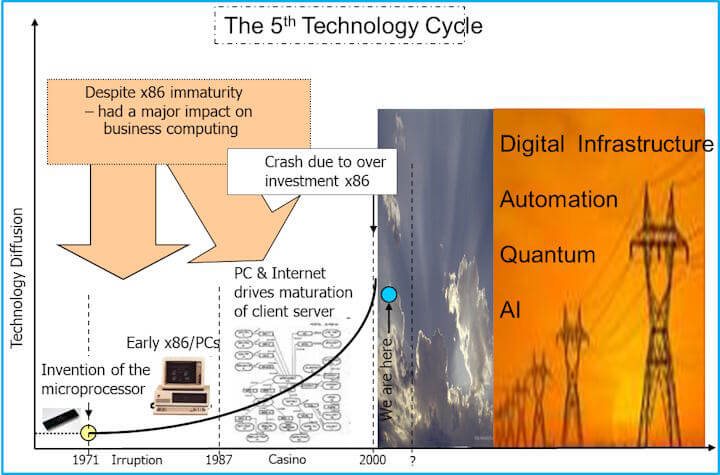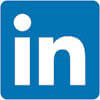
My career in Big Tech. Strategy in the fifth great technology surge

When I first went to work, I never once thought of what I was doing as a “career.” The economy was in shambles. Japan’s auto companies were taking market share from the Big Three US automakers. The Big Three responded by shuttering car plants. The deindustrialization of the US was in full swing. Mortgage rates were over 10%. It seemed that US economic dominance was over. All of this right when I was getting started. At that time, I was just grateful to have a paycheck. Later, I would discover that we were at the beginning of a significant technological surge. I had unintentionally placed myself near the surge’s epicenter.
Act I
I had already been working in tech for a decade and a half when a headhunter targeted me. It was for a job in IBM’s global services unit. I got the job, and the team was suddenly dissolved eight months later. Not knowing anything about IBM, I found an opportunity in the manufacturing division. Typically, IBMers stay in the same division as they move between jobs in their careers. Since I didn’t know anybody, I didn’t know any better. What a remarkable turn of events that was for me.
First off, my manager, Barbara Reynolds, was terrific. She genuinely cared about the people she managed. Barbara got the most out of us in the teams she led. My family and I had moved to Poughkeepsie, NY, for that job. In very short order, I was told to write a paper for the chairman’s office. Gerstner wanted to understand how each server group would compete against Microsoft, Intel, and Compaq.
A paper changed my life
I was pretty nervous about this assignment, as my writing skills had never set the world on fire. I was a brand-new competitive analyst to boot. My analyst peers all had PhDs, and that was their chosen career. Fortunately, I was assigned great resources. Mike Swanson, an IBM fellow, knew what he wanted strategically from the paper.
This made the paper, which was technically complex, much easier to write. That and the first draft (80 pages), they said, was good. Now write a summary in 20 pages. I did, and they said, ‘Great, now write a summary of all this in two pages.’ I did. They then told me that he reads the two-pager. If he likes that, he proceeds to the 20-pager. If Gerstner liked that, he then read the 80-page book. He must have been pleased with the paper. It remained posted on Gerstner’s personal IBM website for two years after I had filed it, and my GM had to present it to the CEC.

Act I Intermission – Education Loading
On the strength of doing the research and getting this paper accepted I was offered a job back in global services. The VP of the unit took an interest in developing me as we had worked together in a previous company. He assigned me a slew of books to read centered on replicating an MBA in business strategy. The readings were primarily from Harvard’s Portable MBA series with titles such as The New Portable MBA (business and strategy).1 As I read the books we would apply the theory using the portfolio of services I was developing. I was using Porter’s Value Chain model to map out how our services were addressing how our customers create value in their markets. The Porter Value Chain is shown above.
Real world application
Nothing sets theory into deep understanding faster than applying it to real-life problems. And yeah, having your proctor motivating you to internalize the material quickly with tough questions. I think he enjoyed the sessions as well because we approached every problem from opposite ends of the spectrum. Joe would turn everything into mathematical variables and then calculate the solutions. I always worry about variables because if they are off by even a fraction, the result can be totally out of whack. Therefore, I used qualitative logic to contrast with Joe’s quantitative approach.
Arguments like combat
We had some real knock-down, drag-out arguments. When he started calling me ‘professor,’ I knew he was no longer interested in the debate. Once, when he stumbled upon a variable that I didn’t recognize, I returned to his office 30 minutes later. He said, “No, no, the answer you give in live combat inside the Thunderdome stands as your answer. No take backs after the fact.” Many times, he brought up topics I was not familiar with, such as how to merge a new group into IBM. Sometimes I think he argued with me to measure the speed of my thinking.
As I went through the portable MBA, my prior experiences raised questions about the theory, and I sought out other tools. The second primary tool I added to my strategy toolbox was the five-domain image of theOSI stack layers. Because of our position back then in the microprocessor revolution, I would utilize the OSI system stack far more frequently to measure how much of the market my solutions were addressing, as well as how quickly x86 technology was maturing.

Tracking the progress of WinTel
Because x86 microprocessor technology was so very new in servers, enterprise customers were in effect rolling their own solutions. Independent business units were deploying the Wintel (Windows & Intel) servers, leaving IT to support the technology.
This created major pain points where the OSI layers met. Resolving the pain points were the values the services were designed to address. The image above shows the the logical spaces between each of the OSI layers customer IT departments would end up supporting in the face of no standards.
The last major piece of the puzzle I found was the answer to questions like what time is it in the development and lifecycle of microprocessors technology? And how could I tell what was a significant advancement in innovation and therefore was justifiable in building out new services or modifying my units strategy? Those were questions which really bugged me if I didn’t feel like I had a grip on them.
Those questions were answered when I read Carlota Perez’s Technological Revolutions and Financial Capital: The Dynamics of Bubbles and Golden Ages. I will provide some examples of her model below. Still, for a deeper understanding of the immensity of her breakthrough, which is reflected in the model that accurately represents reality, I will discuss the incredible breakthrough of Carlota Perez.

Act II
The chart above was created in 2005. I outlined the history of how we arrived at our current position in 2005 and then explained how Clouds would come to dominate during the Synergy phase. For example, the ubiquity of power lines from the 3rd technology cycle was depicted during the Maturity phase to illustrate how widespread the technology would become. In the slide above, you still see the gentle “S” curve from Carlota’s model.
With the tools, theory, and 20 years of working experience in the fifth significant technological surge, I had what I needed to feel no longer like an impostor and to spend the second half of my career as a services portfolio manager and the US offering strategist. The second half of my career began in earnest when I went to work with the late, great Bob Neave, who would become my closest friend in life. Bob cared intensely about IBM, and I was focused totally on the strategy. We perfectly complemented one another at work and respected the hell out of one another.
Technology cycles baked into the strategy
I built so much of Perez’s technology cycles into the offering strategy, one of Bob’s peers once commented “oh please no more about those #*~# Klondike bars.” Bob and I referred to the theory as Kondratiev cycles back then. Hence the Klondike bar crack. IBM was in major cost cutting mode at that time. In the latter 2000s an order came down to reduce the offerings team by 40%. Bob was consuming tums tablets like they were tic tacs due to the enormous stress levels as he really cared about the team which he had for the most part assembled. He and two others were the inaugural offering managers in the unit. Bob progressed into offering management due to his keen business sense. He had said to me many times, the word manager is both a noun and a verb.
Meaning a managers job was not just to issue orders but to actively remove any obstacles and motivate their teams.2 Sadly his drive for the job quite literately cut Bob’s life short. He was still in his 40s.
Act III
The third all-time great manager I had was Ken Haynes. We had been peers on Bob’s team. Ken took the helm in managing the team later and when an opening occurred in software services he gave me the job. It was in this job that all training and theory was applied and would assist in generating hundreds of millions in revenue for Open Source (OS) support services both commercial and community distributions,3 the commercially supported versions of the software services. When I took that job, the Open Source revenue was generated using spreadsheets for each sale! And was generating a piddling $5Mish annually in revenue. I was told this was due to IBM customers not using OS software. Total nonsense in the face of the huge growth rates in OS adoption rates in the marketplace.
Applying the cycles theory to Open Source
Knowing where we were in the 5th great surge’s technology cycle enabled me to focus on building out software offerings which would tap into the monster OS growth rates. Strategy is one thing but it took a team, with new BDE’s landing some of the largest OS clients. Tom Clatterbuck4 designed and built a tool for fast and accurate complex quotes, and Ken Haynes faith in my strategy as he invested in the resources required to stand the renovated offerings up. It took more than this, but they were the majors. Now I know that Arvind is the force behind IBM’s purchasing Red Hat. But what Arvind doesn’t know is that his strategy was assisted by what we did in expanding OS support services.
This was because IBM managed all external fixed costs at the time. Every nickel that was to be spent on external goods was required to be reviewed by a board (GSB). That requirement was implemented just as we were ramping up the portfolio and supercharging revenue growth. That meant that every single deal for years to the tune of hundreds of millions of dollars had to pass through that review board. I am sure Arvind found some additional support from the executives for buying Red Hat, as the board executives had to sign off on every TSS (now TLS) OS deal. I am confident that the TLS revenue growth created an excellent supporting business case for IBM to purchase Red Hat!
Act IV
Since this page is not my biography I intentionally have left out many of the bits. Rather the page is how I used and continue to use Perez innovation cycle theory. Let’s conclude with the 4th great manager I have had at IBM. Chris Bonnell hired me to assist in managing the non-IBM portions, what we call Multi-Vendor Services (MVS), for some of the top 100 accounts. I had spent years building the strategy and the offerings for many of the MVS offerings, therefore this role fits me well. Chris is amazing. Like Barbara, Bob and Ken she deploys my skills to maximum advantage. She is a tireless worker who constantly pitches in at night or even on weekends. All of my “Big Four” managers share that energy, intelligence and laser focus on the business.
Now I realize at my age this is the 4th act of my unintended career. Clearly I won’t finish the fifth great surge working inside the tornado of Big Tech. The end of the current technology cycle is two(+) decades into the future. I will however continue to work at documenting and contributing in the evolution of the macro-economic models and theory in the core technologies which power each cycles surge.
My final post on LinkedIn on my last day in Big-Tech
If you have not read the section on Carlota’s model, it is highly recommended that you do so.

- List of books: Competitive Advantage: Creating and Sustaining Superior Performance. By Michael E. Porter. Published by Free Press, 1985. Competitive Strategy: Techniques for analyzing industries and competitors. By Michael E. Porter. Published by Free Press, 1984. The Innovator’s Dilemma. When New Technologies Cause Great Firms to Fail. By Clayton Christensen Publisher: Harvard Business Review Press. 1997. The Portable MBA in Strategy. By Liam Fahey & Robert Randall. Wiley Publishing. 1994. The New Portable MBA (The Portable MBA Series). Eliza Collins & Mary Anne Devanna. Publisher: Wiley. 1994. Diffusion of Innovations. By Everett Rogers. The Free Press of Glencoe. 1962. ↩︎
- Bob’s stress generated Barrett’s Syndrome which turned into cancer which then spread to his liver before it was discovered. A doctor at Duke medical put him on anti-depressants instead of doing an MRI while the cancer was spreading. We will never know what could have been if the doctor would have simply ordered an MRI instead. Bob left us in late 2010. Ironically at the very same time I developed a brain tumor that was not diagnosed until a couple of weeks after Bob’s funeral service. ↩︎
- Open Source community was the free Open Source software distribution. While Open Source commercial services were the commercially supported distributions of the software. ↩︎
- Tom Clatterbuck was far more than someone who built tools. He built most of the MVS (non-IBM) network and server offerings during his career. Tom remains a very special person. He cares about others and is very smart. ↩︎
